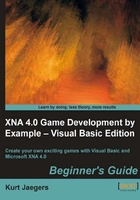
Time for action – handling mouse input
- Add the
HandleMouseInput()helper method to theGame1class:Private Sub HandleMouseInput(mouseInfo As MouseState) Dim x, y As Integer x = mouseInfo.X - CInt(gameBoardDisplayOrigin.X) y = mouseInfo.Y - CInt(gameBoardDisplayOrigin.Y) x = x \ GamePiece.PieceWidth y = y \ GamePiece.PieceHeight If (x >= 0) And (x <= GameBoard.GameBoardWidth) And (y >= 0) And (y <= GameBoard.GameBoardHeight) Then If mouseInfo.LeftButton = ButtonState.Pressed Then _gameBoard.RotatePiece(x, y, False) timeSinceLastInput = 0 End If If mouseInfo.RightButton = ButtonState.Pressed Then _gameBoard.RotatePiece(x, y, True) timeSinceLastInput = 0 End If End If End Sub
What just happened?
The MouseState class reports the X and Y position of the mouse relative to the upper-left corner of the window. What we really need to know is what square on the game board the mouse was over.
We break the mouse position into X and Y components and subtract the corresponding parts of gameBoardDisplayOrigin from them. Next, we use the Integer Division operator (\) to divide the result by the size of a game board square.
If the resulting X and Y locations fall within the game board, the left and right mouse buttons are checked. If the left button is pressed, the piece is rotated counter clockwise. The right button rotates the piece clockwise. In either case, the input delay timer is reset to 0, since input was just processed.
Letting the player play!
Only one more section to go and you can begin playing Flood Control. We need to code the Update() method to tie together all of the game logic we have created so far.